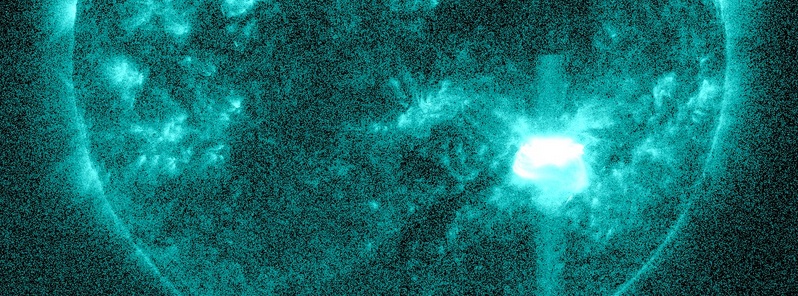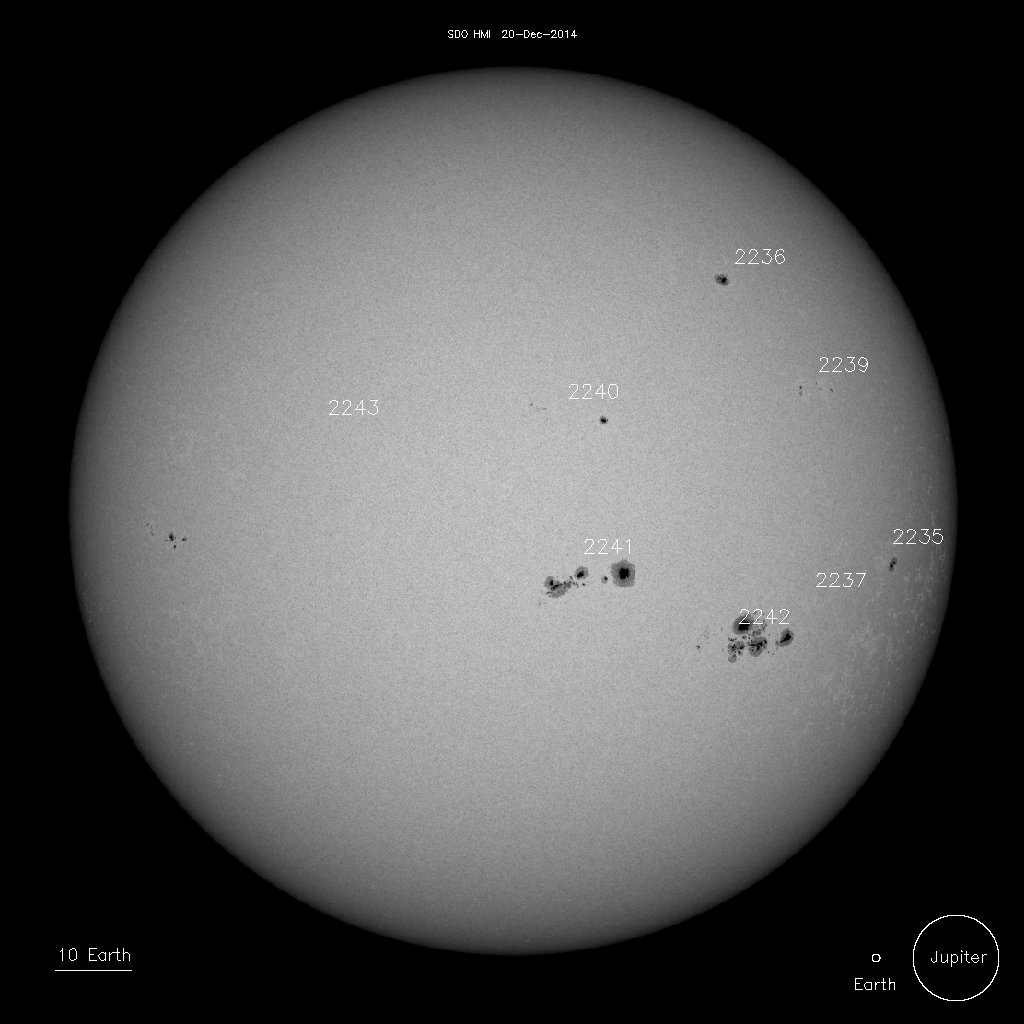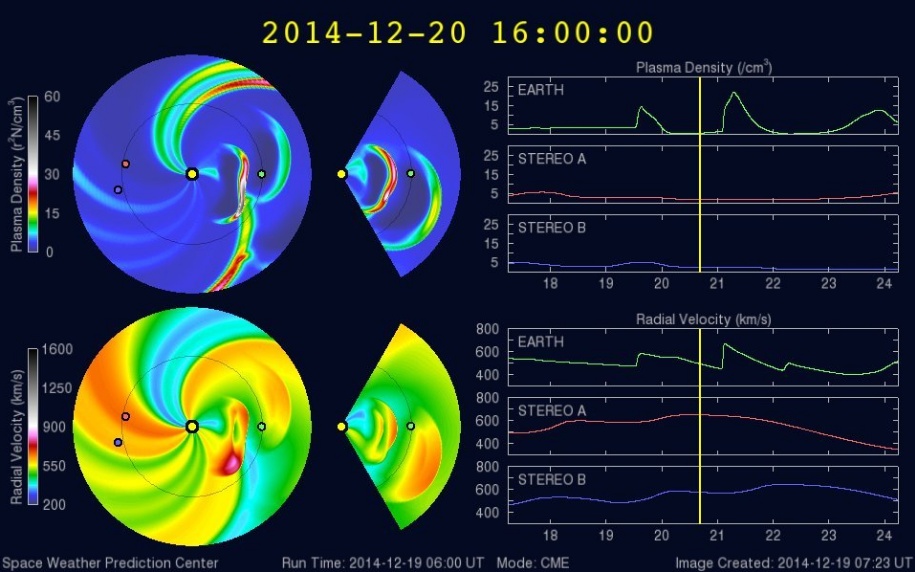Major solar flare measuring X1.8 erupted from Region 2242

A major solar flare measuring X1.8 (R3-Strong Radio blackout) at its peak time erupted from Region 2242 ('beta-gamma-delta') at 00:28 UTC on December 20, 2014. The event started at 00:11 and ended at 00:55 UTC.
A Type II radio emission with an estimated velocity of 900 km/s was associated with the event. Type II emissions typically indicate a Coronal Mass Ejection (CME) is associated with a flare event.
A long duration 10cm radio burst lasting 52 minutes, with peak flux of 2300 sfu was also associated with the event. A 10cm radio burst indicates that the electromagnetic burst associated with a solar flare at the 10cm wavelength was double or greater than the initial 10cm radio background. This can be indicative of significant radio noise in association with a solar flare. This noise is generally short-lived but can cause interference for sensitive receivers including radar, GPS, and satellite communications.
It appears the most of ejected material is directed south of the ecliptic, however, further imagery is needed to determine if there is an Earth directed component. This page will be updated accordingly.
Update: Analysis of SOHO/LASCO coronagraph imagery indicated the majority of the ejecta was not Earth-directed, heading well south of the Sun/Earth plane. (SWPC, Forecast Discussion, December 21, 2014 at 00:30 UTC)
Solar activity is expected to be at moderate (R1-R2/Minor-Moderate) levels for the next three days (December 20 – 22) as Regions 2241 and 2242 remain large and magnetically complex. A chance also exists for an isolated X-class event (R3-Strong) during the same period.

Space Weather Message Code: SUM10R
Serial Number: 652
Issue Time: 2014 Dec 20 0238 UTC
SUMMARY: 10cm Radio Burst
Begin Time: 2014 Dec 20 0018 UTC
Maximum Time: 2014 Dec 20 0024 UTC
End Time: 2014 Dec 20 0100 UTC
Duration: 52 minutes
Peak Flux: 2300 sfu
Latest Penticton Noon Flux: 216 sfu
www.swpc.noaa.gov/noaa-scales-explanation
Description: A 10cm radio burst indicates that the electromagnetic burst associated with a solar flare at the 10cm wavelength was double or greater than the initial 10cm radio background. This can be indicative of significant radio noise in association with a solar flare. This noise is generally short-lived but can cause interference for sensitive receivers including radar, GPS, and satellite communications.
Space Weather Message Code: ALTTP2
Serial Number: 990
Issue Time: 2014 Dec 20 0150 UTC
ALERT: Type II Radio Emission
Begin Time: 2014 Dec 20 0050 UTC
Estimated Velocity: 900 km/s
Description: Type II emissions occur in association with eruptions on the sun and typically indicate a coronal mass ejection is associated with a flare event.
Space Weather Message Code: SUMX01
Serial Number: 111
Issue Time: 2014 Dec 20 0100 UTC
SUMMARY: X-ray Event exceeded X1
Begin Time: 2014 Dec 20 0011 UTC
Maximum Time: 2014 Dec 20 0028 UTC
End Time: 2014 Dec 20 0055 UTC
X-ray Class: X1.8
Optical Class: 2b
Location: S19W29
NOAA Scale: R3 - Strong
Comment: NOAA Active Region 12242; optical class is preliminary
Potential Impacts: Area of impact consists of large portions of the sunlit side of Earth, strongest at the sub-solar point. Radio - Wide area blackout of HF (high frequency) radio communication for about an hour.

Sunspots
There are currently 8 numbered sunspot regions on the Earth side of the Sun. Continued growth was observed in Regions 2241 (S09W06, Ekc/beta-gamma-delta) and 2242 (S18W29, Ekc/beta-gamma-delta), both maintaining East-West oriented inversion lines during last 24 hours. New Region 2243 was numbered yesterday, but it remained inactive. All other active regions were unremarkable.


Sunspots on December 20, 2014. Image credit: NASA SDO/HMI
2235 – Beta
2236 – Alpha
2237 – Alpha
2239 – Beta
2240 – Beta
2241 – Beta-Gamma-Delta
2242 – Beta-Gamma-Delta
2243 – Alpha
Geospace forecast
The geomagnetic field is expected to begin December 20th with active conditions and the chance for an isolated minor geomagnetic storm (NOAA Scale- G1) when the December 17 CME is expected to provide a glancing blow impact to Earth's magnetic field.
By early to midday December 21 the second CME, from December 18, is expected to cause active to major storm (G2-Moderate) conditions as it impacts the geomagnetic field.
December 17th and 18th CMEs are visible heading toward Earth on WSA ENLIL Solar Wind Prediction model below:


Featured image: NASA SDO/AIA 131 at 00:27 UTC on December 20, 2014.

Commenting rules and guidelines
We value the thoughts and opinions of our readers and welcome healthy discussions on our website. In order to maintain a respectful and positive community, we ask that all commenters follow these rules:
We reserve the right to remove any comments that violate these rules. By commenting on our website, you agree to abide by these guidelines. Thank you for helping to create a positive and welcoming environment for all.